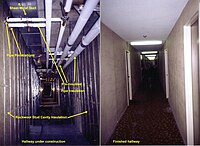
Photo from wikipedia
Abstract Both global and local heating phenomena can potentially influence the building thermal performance and comfort. The residential construction sector had a real estate “boom” in the beginning of the… Click to show full abstract
Abstract Both global and local heating phenomena can potentially influence the building thermal performance and comfort. The residential construction sector had a real estate “boom” in the beginning of the 2000’s in Sao Paulo and there is no available information on how this recent built stock performs under the current climate and how it will do, considering the warming climate. Therefore, this study addresses the real estate residential apartment buildings developed in the 2000’s, aiming to investigate their thermal performance and expected comfort conditions, considering the urban present and future climate. The average air temperature difference (ΔT) between the high-rise dense urban area and the suburban stations was registered and then coupled to the future weather file. Comparing the apartment’s thermal performance under the base weather file (SWERA) and the Future (2045-2074) + UHI, in yearly values, an important decrease in comfort hours (from 81% to 65%) was found, while in a hot period (February) the results are much more critical (64% heat discomfort hours). It is important to address how central is the adaptability for improving the domestic comfort conditions, especially in the pandemic and post pandemic scenarios, when people are expected to spend more time inside their homes.
Journal Title: Energy and Buildings
Year Published: 2021
Link to full text (if available)
Share on Social Media: Sign Up to like & get
recommendations!